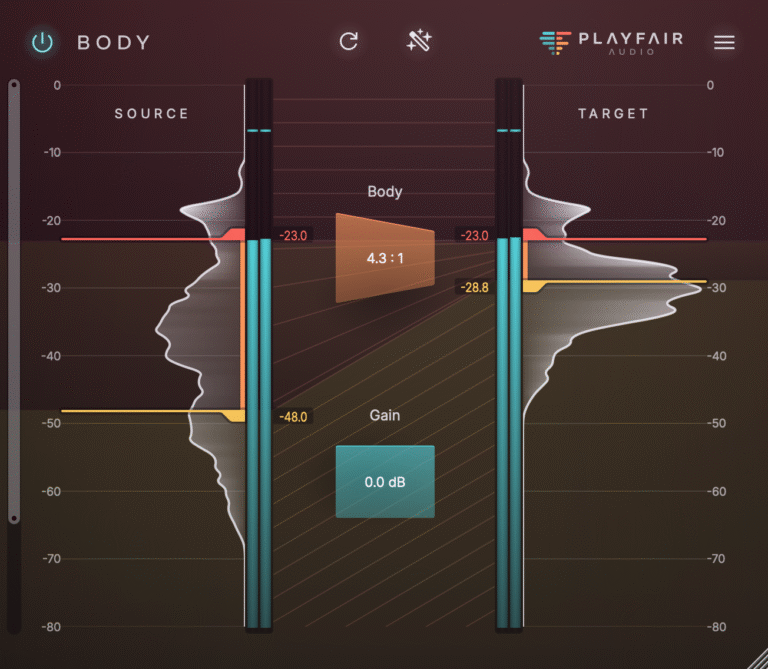Parallel compression has earned its place in the mix engineer’s toolkit. When used well, it can bring energy, weight and clarity to a mix without squashing the life out of it. It’s been used on everything from vocals to drums to full mixes, and while people sometimes refer to it as a “secret weapon,” it’s really more of a modern staple.
That said, it’s not without drawbacks. Like any technique, it depends on context. Sometimes it gives a track the lift it needs. Sometimes it creates more problems than it solves.
Here’s a look at what parallel compression does well, where it can go wrong, and how we’ve designed Dynamic Grading to give you the same benefits, but with more precision and less hassle.
What Is Parallel Compression?
Parallel compression means blending a heavily compressed version of a signal with the unprocessed original. Rather than compressing a track outright, you duplicate it, process one version with strong compression, and mix the two together.
This lets you retain the natural dynamics and transients of the dry signal, while using the compressed version to add density and sustain. It’s commonly used on drums to add weight, on vocals to increase presence, or on entire mixes to boost perceived loudness without losing clarity.
The Pros of Parallel Compression
1. More Punch and Presence
By blending in a compressed layer, you can increase the perceived impact of a sound without crushing the transients. It can make drums feel thicker, vocals more present, and mixes more energetic.
2. Improved Detail
Parallel compression can bring up the quieter parts of a performance that might otherwise get lost. Room tone, breath, soft phrases and ghost notes can all become more audible and engaging.
3. Flexible Blending
Because you’re not committing to a fully compressed sound, you have the freedom to find the sweet spot between control and expression. This makes it easy to adapt to different genres and styles.
4. Perceived Loudness Without Flattening
Blending in compression can add energy and density without the drawbacks of pushing a limiter too hard. This helps keep mixes dynamic and musical, even at higher levels.
The Cons of Parallel Compression
1. Phase Issues
If your DAW doesn’t compensate properly for latency or routing, you may encounter phase problems between the dry and compressed signals. This can result in unwanted cancellations or frequency build-up, especially in the low end.
2. Unwanted Artefacts
Because you’re raising the level of the compressed signal, you’re also raising everything in it. That might include mouth noises, headphone bleed, hiss or harsh room reflections. The detail can be useful, or it can be distracting.
3. More Complexity
Parallel chains often require extra routing, gain staging and EQ balancing. While the idea is simple, managing multiple versions of a signal can quickly become a time sink, especially when working fast.
4. Inconsistent Results
If you’re not careful with compression settings, the blended signal can smear transients, soften grooves or reduce the natural feel of a performance. What starts as punch can quickly turn into mush.
Why We Built Something Different
We’ve used parallel compression plenty over the years. We know how effective it can be. But we also know how often it becomes more fiddly than it needs to be. Routing issues, phase corrections, EQ mismatches and constant rebalancing all take time away from focusing on the mix itself.
That’s why we built Dynamic Grading. It gives you the musical benefits of parallel compression without needing duplicate tracks, blend faders or workarounds. More importantly, it lets you decide exactly how different parts of the signal behave based on dynamic intensity, not just level.
Instead of just blending wet and dry signals, Dynamic Grading lets you shape the full dynamic picture of your sound — loud peaks, mid-level body and soft details — all with their own set of controls.
The Difference with Dynamic Grading
With Dynamic Grading, you’re not stuck adjusting one global compressor and trying to balance it against the original signal. You can shape transients without lifting background noise. You can add presence to mid-level dynamics without pulling up every breath and click. And you can control the tail of a signal without dulling its attack.
It’s fast, visual and direct. You see exactly what you’re affecting, and you hear results immediately.
Parallel compression works well when the balance is right. But it often relies on workaround thinking — duplicating tracks, managing phase, solving issues it introduced elsewhere.
Dynamic Grading gives you a different option. It offers the benefits of parallel compression — more punch, more detail, more energy — but with fewer steps and more precision. You can sculpt the sound from the inside, rather than layering two versions on top of each other.
If you’re looking for a more musical, less cluttered way to handle dynamics, it’s worth a listen.
